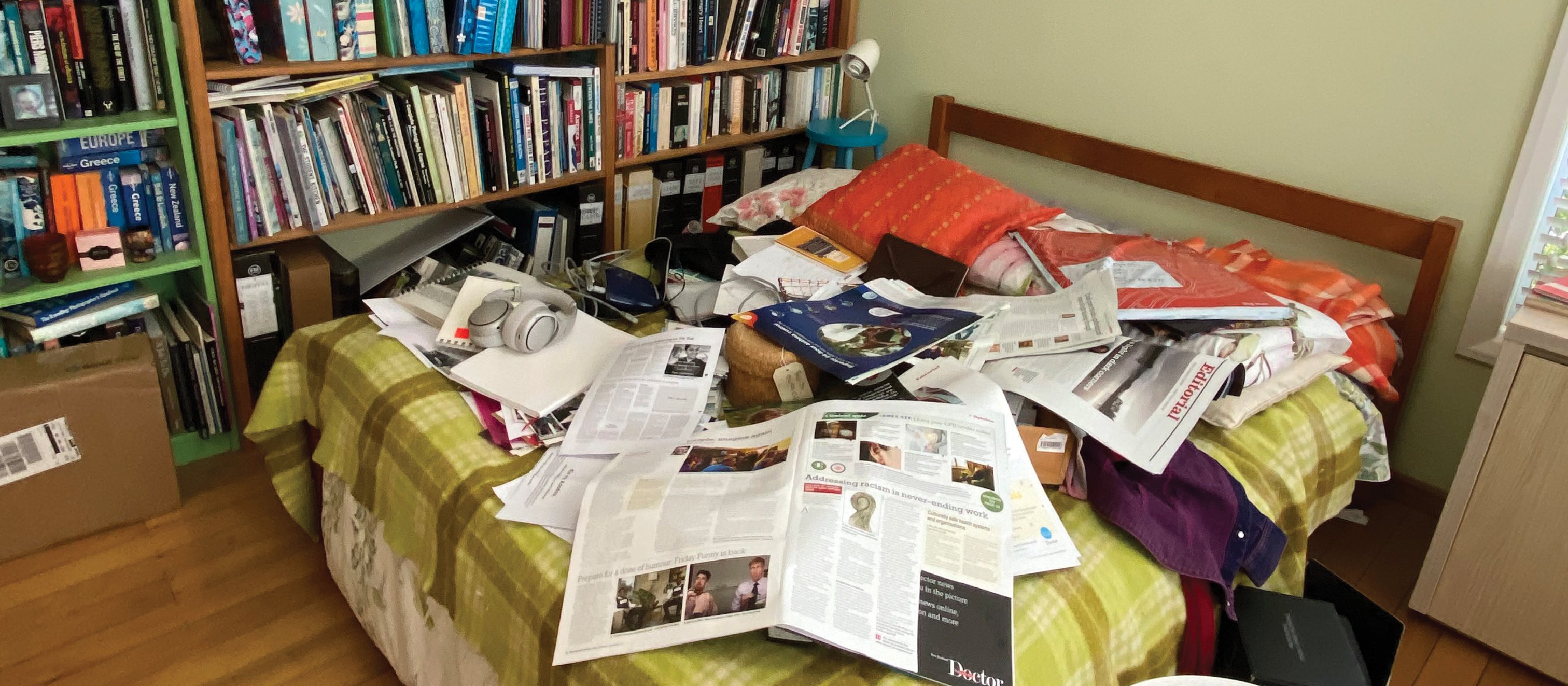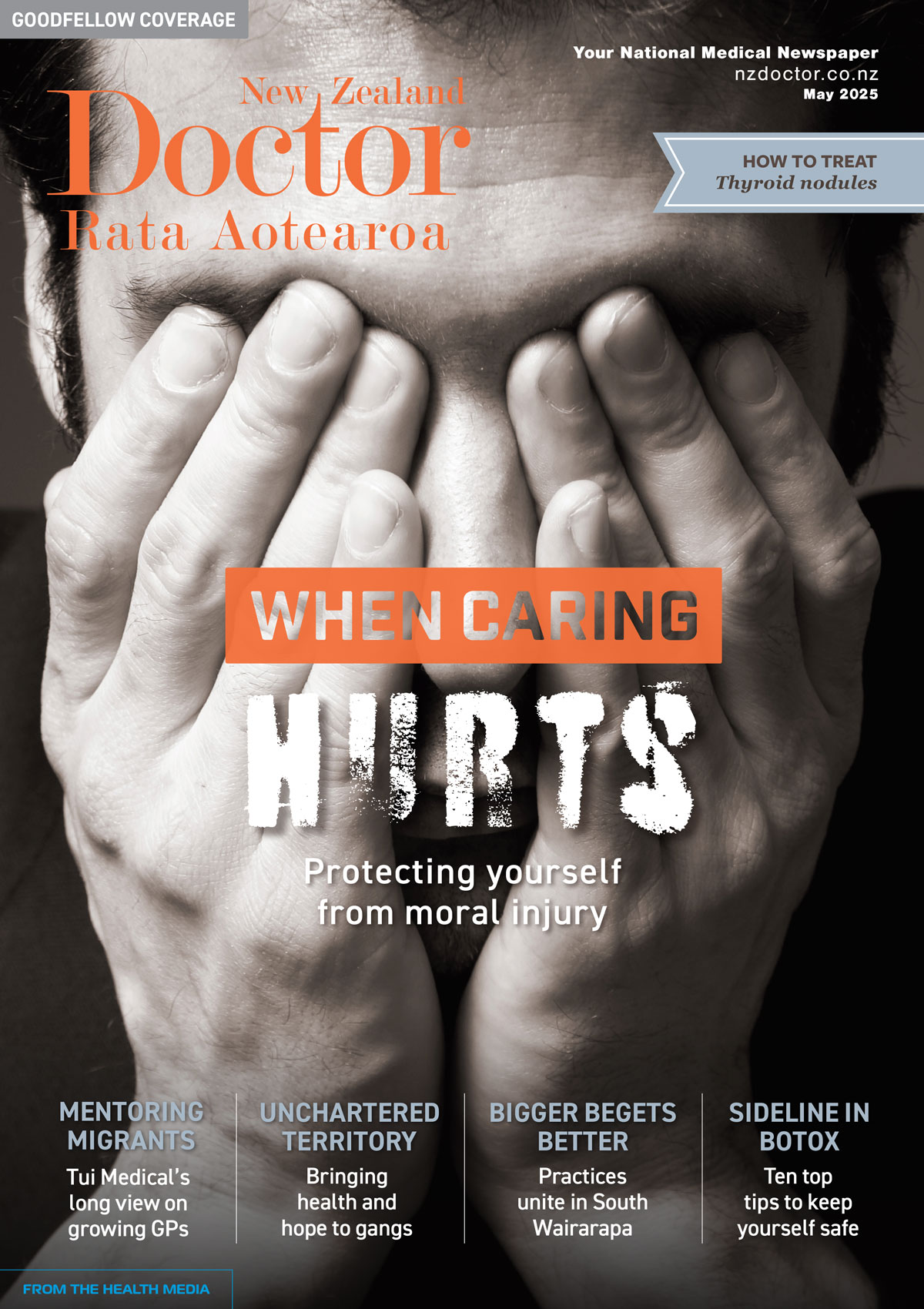Respiratory physician Lutz Beckert considers chronic obstructive pulmonary disease management, including the prevention of COPD, the importance of smoking cessation and pulmonary rehabilitation, and the lifesaving potential of addressing treatable traits. He also discusses the logic of inhaler therapy, moving from single therapy to dual and triple therapy when indicated, as well as other aspects of management
Lockdown dreads
Lockdown dreads

Editor Barbara Fountain finds the monotony of the daily commute to the frontroom office is creating a new playlist for life
The term “for profit” has the effect of suggesting the provider’s prime motivation is making money
I have found a new condition and named it lockdown dreads. You might surmise it’s a psychological affliction, arising, perhaps, from the ritualised and narrow life of working from home under COVID-19 restrictions.
By which I mean, repeatedly walking from bedroom to bathroom to kitchen to bathroom to bedroom to front room (aka home office), and doing it all again in reverse at the end of the day.
But no, the condition I have diagnosed is, in fact, a physical affliction arising from days spent walking from bedroom to bathroom to kitchen to front room...It has emerged that omitting the final lap with its glance-in-the-mirror tidying of the hair will, in the longer term, lead to lockdown dreads.
I realise that dreadlocks, in the grand scheme of traumas COVID has showered upon us, are but a tiny physical marker. But then you find yourself and your dreads channelling the great Bob Marley – and, well, it’s pretty cosmic. “One love, one heart, let’s get together and feel alright”, etc. Not to be taken literally, of course, for those of us facing bubble, bubble (toil and trouble) rules, but in the figurative sense of joining together to fight the Delta bug, totally in line with the determination to get people vaccinated.
Bob’s reggae anthem even pays tribute to the anti-vax conspiracy folk, “Have pity on those whose chances grow thinner”.
Speaking of conspiracy theories, and drawing a long bow, I’ve been vexed recently by the health sector’s use of language. It arises from the problems we’ve seen with COVID-19, when GPs, pharmacists and others in the primary care sector are a recognised part of the health system – until they are not. This is usually around the time something needs to be paid for – equipment, human resource, disposables – at which point the distinction between private and public comes into sharp focus and those in the “private” sector are told to bog off.
That’s a simplification. Relations have improved. But the language remains, and it has its pitfalls as we look to reform the system and create a one-system culture – one heart, if you’ll excuse me quoting Bob again.
In primary and community care, the majority of health providers – GPs, midwives, pharmacists, physiotherapists, podiatrists, optometrists, dietitians, psychologists, and the rest – are private businesses, many of whom provide services in the public health system. A very small number are even listed on the stock exchange.
Similarly trusts, charitable companies and incorporated societies provide services in primary care – many for high-needs patients with chronic conditions, but also many in times of short-term high need for individual patients. For example, cancer support services.
The entire health system rests on the work of these community providers.
So, start trying to delineate them on the basis of their business model or the people they treat, and it can get messy. The term “for profit” has the effect of suggesting the provider’s prime motivation is making money. And it sets them up against the “not for profit” service, which we actually hope is making a profit because we want it to be sustainable. I have great admiration for the many trusts that work in primary care and even greater admiration that they stay afloat.
Taking a page from the book of the primary care pioneer and GP Jonathan Simon, I prefer to think all entities in the field of providing health services are “not for loss”, irrespective of how they are structured or the people they serve.
In the “one-heart system”, what should be relevant is the ability of a provider to provide services that meet the requirements of the reformed health system. The legal structures they use to carry out the work should be irrelevant, barring fraud.
We should be wary, in the coming months of reforms attempting to refocus on equity, partnership, excellence, sustainability, and patient and whānau-centred care, that old habits of language do not linger on, deadlocking attempts at change.
You might call it deadlock dread.




![Barbara Fountain, editor of New Zealand Doctor Rata Aotearoa, and Paul Hutchison, GP and senior medical clinician at Tāmaki Health [Image: Simon Maude]](/sites/default/files/styles/thumbnail_cropped_100/public/2025-03/Barbara%20Fountain%2C%20editor%20of%20New%20Zealand%20Doctor%20Rata%20Aotearoa%2C%20and%20Paul%20Hutchison%2C%20GP%20and%20senior%20medical%20clinician%20at%20T%C4%81maki%20Health%20CR%20Simon%20Maude.jpg?itok=-HbQ1EYA)
![Lori Peters, NP and advanced health improvement practitioner at Mahitahi Hauora, and Jasper Nacilla, NP at The Terrace Medical Centre in Wellington [Image: Simon Maude]](/sites/default/files/styles/thumbnail_cropped_100/public/2025-03/2.%20Lori%20Peters%2C%20NP%20and%20advanced%20HIP%20at%20Mahitahi%20Hauora%2C%20and%20Jasper%20Nacilla%2C%20NP%20at%20The%20Terrace%20Medical%20Centre%20in%20Wellington%20CR%20Simon%20Maude.jpg?itok=sUfbsSF1)
![Ministry of Social Development health and disability coordinator Liz Williams, regional health advisors Mary Mojel and Larah Takarangi, and health and disability coordinators Rebecca Staunton and Myint Than Htut [Image: Simon Maude]](/sites/default/files/styles/thumbnail_cropped_100/public/2025-03/3.%20Ministry%20of%20Social%20Development%27s%20Liz%20Williams%2C%20Mary%20Mojel%2C%20Larah%20Takarangi%2C%20Rebecca%20Staunton%20and%20Myint%20Than%20Htut%20CR%20Simon%20Maude.jpg?itok=9ceOujzC)
![Locum GP Helen Fisher, with Te Kuiti Medical Centre NP Bridget Woodney [Image: Simon Maude]](/sites/default/files/styles/thumbnail_cropped_100/public/2025-03/4.%20Locum%20GP%20Helen%20Fisher%2C%20with%20Te%20Kuiti%20Medical%20Centre%20NP%20Bridget%20Woodney%20CR%20Simon%20Maude.jpg?itok=TJeODetm)
![Ruby Faulkner, GPEP2, with David Small, GPEP3 from The Doctors Greenmeadows in Napier [Image: Simon Maude]](/sites/default/files/styles/thumbnail_cropped_100/public/2025-03/5.%20Ruby%20Faulkner%2C%20GPEP2%2C%20with%20David%20Small%2C%20GPEP3%20from%20The%20Doctors%20Greenmeadows%20in%20Napier%20CR%20Simon%20Maude.jpg?itok=B0u4wsIs)
![Rochelle Langton and Libby Thomas, marketing advisors at the Medical Protection Society [Image: Simon Maude]](/sites/default/files/styles/thumbnail_cropped_100/public/2025-03/6.%20Rochelle%20Langton%20and%20Libby%20Thomas%2C%20marketing%20advisors%20at%20the%20Medical%20Protection%20Society%20CR%20Simon%20Maude.jpg?itok=r52_Cf74)
![Specialist GP Lucy Gibberd, medical advisor at MPS, and Zara Bolam, urgent-care specialist at The Nest Health Centre in Inglewood [Image: Simon Maude]](/sites/default/files/styles/thumbnail_cropped_100/public/2025-03/7.%20Specialist%20GP%20Lucy%20Gibberd%2C%20medical%20advisor%20at%20MPS%2C%20and%20Zara%20Bolam%2C%20urgent-care%20specialist%20at%20The%20Nest%20Health%20Centre%20in%20Inglewood%20CR%20Simon%20Maude.jpg?itok=z8eVoBU3)
![Olivia Blackmore and Trudee Sharp, NPs at Gore Health Centre, and Gaylene Hastie, NP at Queenstown Medical Centre [Image: Simon Maude]](/sites/default/files/styles/thumbnail_cropped_100/public/2025-03/8.%20Olivia%20Blackmore%20and%20Trudee%20Sharp%2C%20NPs%20at%20Gore%20Health%20Centre%2C%20and%20Gaylene%20Hastie%2C%20NP%20at%20Queenstown%20Medical%20Centre%20CR%20Simon%20Maude.jpg?itok=Z6u9d0XH)
![Mary Toloa, specialist GP at Porirua and Union Community Health Service in Wellington, Mara Coler, clinical pharmacist at Tū Ora Compass Health, and Bhavna Mistry, specialist GP at Porirua and Union Community Health Service [Image: Simon Maude]](/sites/default/files/styles/thumbnail_cropped_100/public/2025-03/9.%20Mary%20Toloa%2C%20Porirua%20and%20Union%20Community%20Health%20Service%20in%20Wellington%2C%20Mara%20Coler%2C%20T%C5%AB%20Ora%20Compass%20Health%2C%20and%20Bhavna%20Mistry%2C%20PUCHS%20CR%20Simon%20Maude.jpg?itok=kpChr0cc)